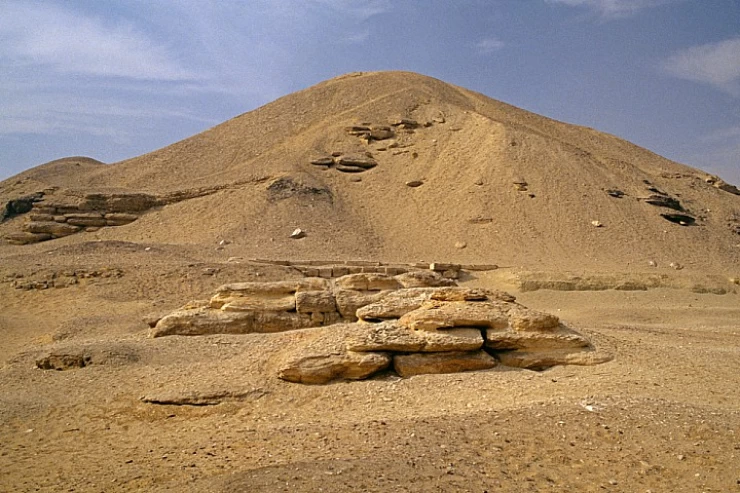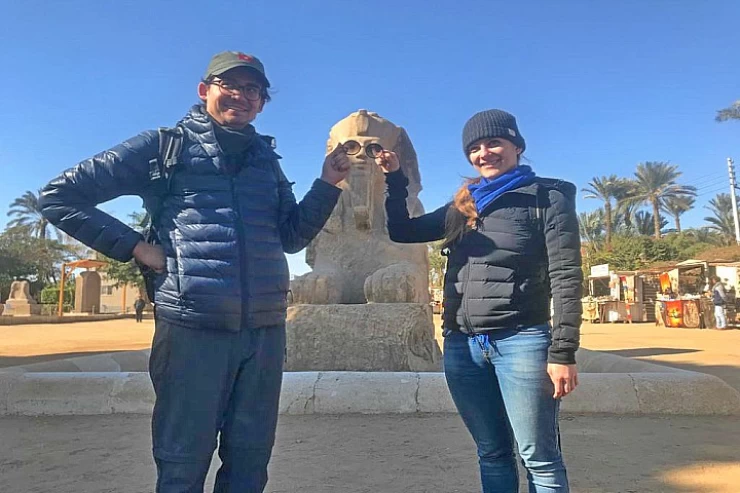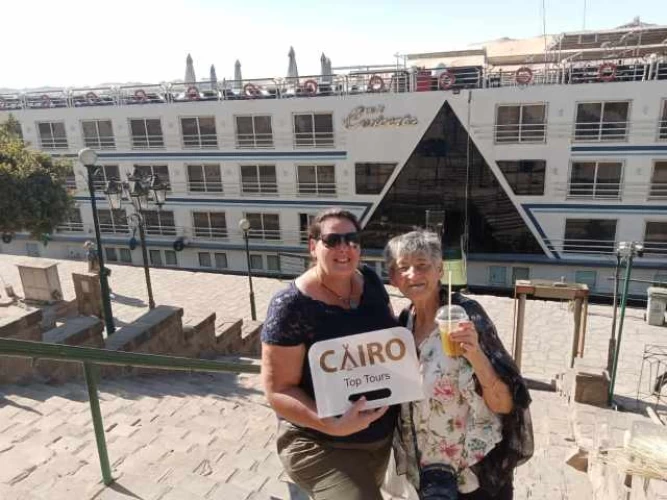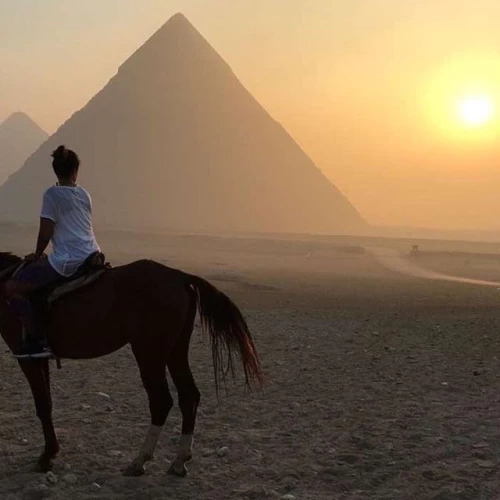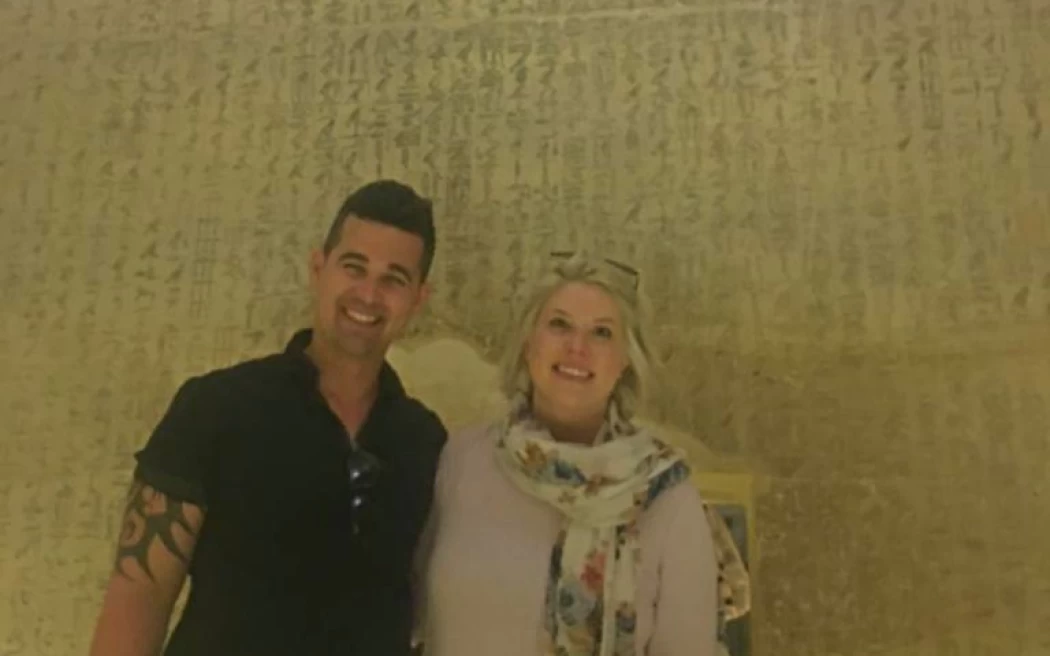
Pyramide de Teti à Saqqara
Pyramide de Teti à Saqqara
La pyramide de Teti à Saqqara, près de Gizeh, a été construite par le pharaon Teti, fondateur de la sixième dynastie qui a gouverné l'Égypte après le pharaon Unas. Ses dimensions et sa pente étaient similaires à celles des pyramides des prédécesseurs et successeurs de Teti. Même dans la façon dont il a été construit, il a suivi l'exemple d'Unas: la maçonnerie centrale était faite de blocs de pierre accrétés, enveloppés de calcaire fin. L'ancienne civilisation égyptienne n'arrêtera pas de nous éblouir à chaque fois que nos yeux tombent sur les structures qu'ils ont laissées et malgré la renommée des pyramides de Gizeh en particulier celle construit par le roi Chéops, "la grande pyramide" et la grandeur de l'architecture. Il y a beaucoup d'autres gigantesques pyramides construites dans l'Égypte ancienne, peut-être n'ont-elles pas eu la chance d'être aussi célèbres que celles de Gizeh. Mais ils fascinent toujours quiconque les voit et il sera séduit par la grandeur de leurs constructeurs, leur inscription et leurs détails, tout comme la pyramide Teti à Saqqara.
La pyramide de Teti qui fut le fondateur de la 6e dynastie (2345-2181 avant JC). Sa pyramide est régulièrement vue lors des excursions d'une journée du Caire à Saqqarah et elle a été découverte en 1853 par Mariette. Mais c'est surtout un tas de gravats en danger constant d'être recouvert par le sable. Il a gouverné l'Égypte ancienne pendant l'ancien royaume de 2323 à 2291 avant J.-C. Son épouse, la reine Ipwet, est la fille du roi Unas, dernier roi de la 5e dynastie. La reine était la mère de l'héritier de Teti, le roi Pepi I. Les historiens pensent qu'elle est celle qui lui a donné le pouvoir royal. Presque tous les principaux fonctionnaires de la cour du roi Wenis sont restés au pouvoir pendant le règne de Teti. Le roi a été assassiné par ses gardes pour des raisons mystérieuses.
Teti a accordé plus de terres à Abydos et son nom a été inscrit dans Hatnub. Il a construit une pyramide à Saqqarah, l'un des sites archéologiques les plus explorés à faire au Caire. Elle est appelée par les Egyptiens modernes la "Pyramide de la prison". La majeure partie de son règne n'a pas été documentée. Les égyptologues ont découvert une statue de lui en granit noir et rose. La statue est située au musée égyptien. Le gendre de Teti, Mereruka, était aussi son vizir. Le Mastaba de Mereruka est situé à Saqqarah. La pyramide de Teti est entourée de certains des mastabas les plus importants de Saqqarah. La pyramide elle-même s'est détériorée en raison de l'intervention humaine. La chambre funéraire Contient toujours des inscriptions hiéroglyphiques gravées dans des colonnes verticales représentant les textes des pyramides et à l'intérieur de la cartouche du roi Titi, il a dessiné des dizaines de fois. Les textes sont des sorts magiques qui garantissent la vie éternelle du roi et l'aident à conquérir les forces des ténèbres dans l'au-delà. Malheureusement, les textes de la chambre funéraire ont été presque complètement détruits lorsque la pyramide a été utilisée comme carrière dans les siècles anciens suivants.
La sous-structure de la pyramide de Teti est similaire à celle d'Unas, même si elle est légèrement plus grande. Les murs du passage descendant sont recouverts de granit. Ce passage s'ouvre sur une petite chambre de couloir, suivie d'un passage horizontal. Trois herse étaient destinées à bloquer le passage et empêcher les voleurs de profaner l'enterrement. Le passage horizontal débouche dans l'antichambre, qui est située sous le centre de la pyramide. À l'Est se trouve une pièce avec trois niches, qui contenait peut-être des statues du roi. En face des trois niches, à l'Ouest de l'antichambre, se trouve la chambre funéraire. Mais pour son couvercle, qui a été brisé par des voleurs de tombes, le sarcophage de basalte est très bien conservé. C'est le premier à avoir eu une inscription: une seule bande des Textes des Pyramides.
Comme ce fut le cas avec la pyramide d'Unas, les murs de la chambre funéraire, l'antichambre et une partie du passage horizontal sont inscrits avec des textes pyramidaux. Les textes sont bien plus endommagés que ceux d'Unas, ce qui est dû au mauvais état de conservation de la sous-structure de la pyramide.
Des circuits en Egypte remarquables et sûrs ! Avec nos circuits de Pâques en Égypte 2023, vous ressentirez la grâce de l'esprit antique des Égyptiens en explorant les majestueuses pyramides, les temples, les tombeaux qui hantent votre esprit et votre âme tout en bénéficiant du meilleur service. Des meilleures croisières sur le Nil aux forfaits classiques de visites de sites historiques, Cairo Top Tours propose une gamme d'activités et de vacances d'aventure en Égypte. Outre les sites historiques traditionnels, nous proposons une sélection distinctive de safaris dans le désert égyptien à travers le silence magique et l'attrait des Oasis de Siwa, dans le désert égyptien. Choisissez parmi les meilleures offres d'excursions d'une journée en Égypte et choisissez l'une de nos superbes excursions d'une journée au Caire. Nos passionnantes excursions à Louxor et excursions à Assouan vous feront découvrir tous les chefs-d'œuvre historiques de la ville. Notamment la fascinante Vallée des Rois, le fantastique temple de la reine Hatchepsout et les temples uniques d'Abu Simble, le tout accompagné d'un guide expert qui vous expliquera l'histoire de ces incroyables sites.
En Égypte, il existe un endroit spécial appelé Tips About Nile River Attractions (Conseils sur les attractions du fleuve Nil). C'est un endroit où les enfants peuvent se rendre pour découvrir les choses intéressantes près du Nil, ainsi que l'histoire et la culture du Caire islamique.
Saqqara necropolis houses the Teti pyramid, which is one of the most interesting pyramids in decreasing order of age and significance. This pyramid was built for Pharaoh Teti, the first king of the Sixth Dynasty of ancient Egypt, approximately between 2345 and 2333 B.C. In this manner, this structure is an integral part of Ancient Egypt's elaborate royal tomb architecture. The small Teti Pyramid, which may not be as famous as the Great Pyramids at Giza, to this day remains significant because of the Pyramid Texts found inside the Teti Pyramid walls that show what ancient Egyptians believed about religion.
Like other interesting structures, such as the Step Pyramid of Djoser, the Teti Pyramid is located in the Saqqara area. Being, on the outer surface, a small pyramid able to lie behind the monuments, the Teti pyramid radiates considerable spiritual strength and architectural upheavals, which are very fascinating to people in the history of Egypt. That is why this pyramid is affordable for the tourists.
Pharaoh Teti was the first of the Tenth Dynasty rulers of Egypt who built its pyramids. This period marked the end of the apex of the pyramid building of the Old Kingdom’s Fifth Dynasty at the Western Desert and the onset of widespread political and economic troubles. Even during the reign of Teti, who ascended the throne in the flourishing civilization of Egypt, it was a great and rich country of the first order. However, the signs of conflict within the state’s system, which had previously been quite solid and centralized, began to emerge, laying the groundwork for future conflicts within the power depicted so firmly.
Teti came to power after King Unas, the last king of the Fifth Dynasty, completed his reign. He also respected the traditions of the great eras and the pyramid-building culture.
In about twelve years of power only, despite his short rule, Teti's pyramid at Saqqara with its mortuary complex points to his wish somehow to transcend the mortal realm and continue with the veneration of the primitive deities of Egypt. The pyramid is also of great importance when one considers the religious practices of Egypt during the Old Kingdom, owing to Teti's tomb containing Pyramid Texts, which survive to this day as a part of funerary customs in Egypt.
The Pyramid of Teti was once a large structure with a smooth casing of white limestone that made it glisten under the hot desert sun. However, the outer surface of the pyramid has suffered over the years and is now broken. In contrast, the inner grounds have remained relatively intact, thereby maintaining the inner significance of the essence of the pyramid.
With a height of 52 meters (170 feet) and a base measuring 78.5 meters (258 feet) on each side, the Pyramid of Teti is relatively small when compared to the other great pyramids of Giza. However, the most interesting part of the pyramid remains concealed. Its smooth-sided form was already observed as an architectural gesture that evolved from the previous pyramid constructions of the Old Kingdom. However, innovations were within the structure. Particularly, the sacred images and religious texts that were decorated on the walls of the interior parts of the pyramid were new.
Teti's pyramid, like the other royal pyramids of its time, was also built with a mortuary temple and a connected causeway leading to the Valley temple at the bank of the Nile. The causeway functioned both as a ceremonial track for the departed monarch in his traversal to the world beyond and as a path for priests and congregants during burial services. Most of the structure is in ruins today, but its design has shaped the traditions associated with the construction of pyramids in Egypt.
The Pyramid of Teti displays one exceptional characteristic of importance: her Pyramid Texts on the walls of the burial chambers, which are among the earliest known inscriptions of a religious nature. They record detailed prayers, hymns, and spells that contributed towards enabling the pharaoh to inhabit the other world, and they are the most ancient known religious inscriptions in existence.
The texts served the purpose of shielding and assisting the soul of the king in such a way that he is ensured of resurrection and eternal presence with the gods. They contain ways in which the king could rise to the heavens, mention of Ra the sun god, and Osiris the god of the underworld, and prayers to other gods for safety. These religious writings can be considered precursors to the more elaborate, long-written funerary inscriptions that came later on, such as the Coffin Texts and the Book of the Dead during the Middle Kingdom and the New Kingdom.
These writings are of great importance even for present-day archaeologists and historians as they illustrate the religious tenets of ancient people like the Egyptians. The Pyramid Texts in Teti's pyramid are more or less the same as those in the pyramid of his predecessor Unas, suggesting a consistency in the burial practices throughout the dynasties.
The Interior Chambers: A Sacred Journey
Visitors to the Pyramid of Teti can plunge within the structure's interior and see the chambers that housed the urn of the long-dead pharaoh. First, however, visitors must crawl through a dark, narrow, sloping passage that leads to several rooms built to keep the king’s corpse safe and to the spirit’s way to the other world.
What first meets the eye of the visitors who enter the burial chamber is a large stone sarcophagus, which is believed to have contained the body of Teti and which has been placed in the center of the chamber. Even though the design of the sarcophagus is more or less plain, its massive scale and location in the room indicate the importance of the pharaoh’s final resting place.
The Pyramid Texts, which consist of hieroglyphs that are grossly incised on the limestone walls encasing the tomb, line the sides of the burial cell. They are clear poetic and devotional stories that reflect the ancient concepts of the Egyptians and their faith in immortality.
Saqqara Necropolis: Teti’s Pyramid in the Land of the Dead
Тети’s Pyramid is situated in the expansive necropolis of the Saqqara, which was used as a burial ground for thousands of years for the rulers and elites of ancient Egypt. This ancient cemetery in Saqqara is best known for the Step Pyramid of King Djoser, the first man-made monumental structure in the world constructed solely of stone. However, it is far from its only wonder, for it holds countless tombs and pyramids, which show how the ancient Egyptians’ methods of burying their dead progressed throughout the years.
Tombs of the high officials and nobles who served Pharaoh Teti can also be found near the Teti Pyramid for all visitors to experience. The Tomb of Mereruka is one of the most famous and is a beautifully adorned tomb of one of Teti’s viziers. Mereruka’s tomb includes many reliefs showing aspects of daily, rustic, and ritual life that help understand the Old Kingdom in Egypt.
The Saqqara necropolis continues to be a major site for archaeological discovery, with new tombs and artifacts uncovered regularly, shedding light on Egypt’s ancient past.







